Russ Douglas reviews the new Airmaks Katran, a full-length air rifle that also manages to be portable and practical...
Don’t you just love great design? Hmm ‘belt and braces? No, I don’t mean the gent’s braces I wear covertly to keep my breeks (jeans) up, I’m talking about design that’s purely functional, where every component has a specific purpose. Some might call this look ‘tactical’ – but this is definitely ‘tacti-cool’. I adapted this particular model to fit me slightly better, simply by looping a webbing belt, but I’m jumping ahead here. Let’s start with the basics.
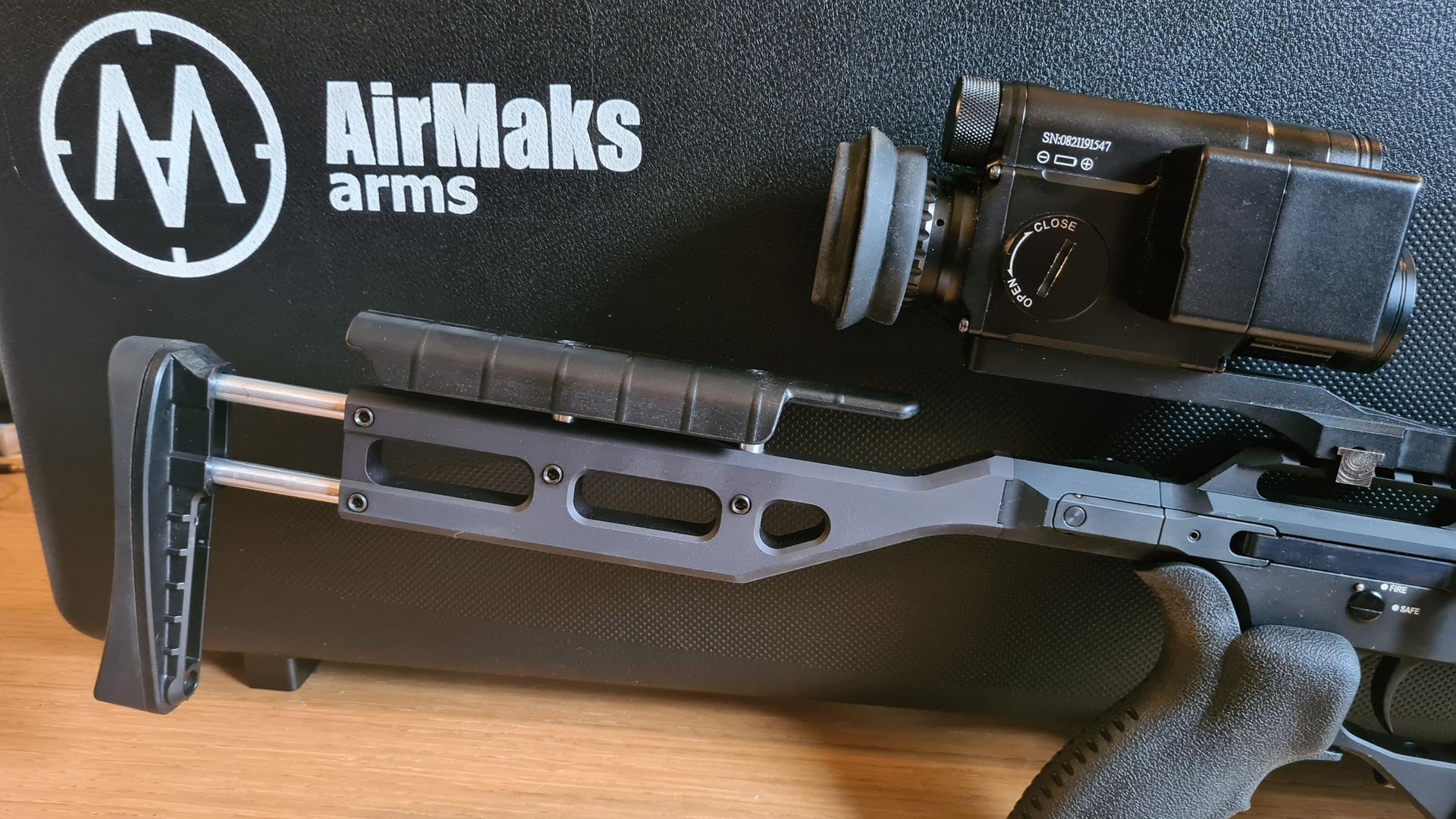 credit: Russ Douglas
credit: Russ Douglas
MEET THE KATRAN
The Katran is a sidelever-cocking multi-shot PCP from Czech gunsmiths, Airmaks, imported by Blackpool Air Rifles and supplied in a tough carry case. Overall layout is traditional, with the stock at the back and a carbon-fibre bottle making a nice ‘warm’ forward handle. One quirk is the perforated alloy accessory sleeve between the action and the forward reservoir. The sidelever and its biathlon-style vertical bar can be swapped across left-to-right, as can the perfectly-sited, resettable AR-style safety catch. So, whether you’re a rightie or a leftie, the cocking lever and positive (but quiet) resettable safety are right there where you want them to be. The reverse side of the safety catch includes a slot, so you can easily tell the rifle’s cocked status, from each side.
There are several versions of the Katran available; compact, standard, or extended models, with conventional, slim air cylinders, or carbon-fibre buddy bottles (300cc or 480cc). Finish is immaculate throughout, with crisp, hard-anodised surfaces everywhere, including the 16-slot Picatinny scope rail and the tastefully fluted, chunky barrel shroud. The topical feature which drew me straight to this particular model is its folding skeletal stock. This unlocks with the push of a sprung button on the left side beside the hinge, then once folded back against the left side of the action, it’s retained by a small magnet; perfect both for fiddle-free retention and release.
This 6.25lb rifle measures 910mm (36 inches) extended and just 655mm (26 inches) folded, although your chosen optic will obviously extend that slightly, ‘overhanging’ the back of the folded action, but it still fitted my rucksack gun slip easily. The trigger breaks crisply at just 12oz, and cocking effort measures barely 5lbs, although only right at the end of the cocking stroke. In addition to the fully adjustable stock, there’s a nicely positioned manometer, amidships, and fore end alloy sleeve complete with numerous keymod accessory rail slots at three, six and nine o’clock (nine in total), perfect for personalising with optional extras. The textured synthetic grip was a little slim width-wise, for me, although it was positive in use, and hollow with a sliding base cap. This offers access to either a small storage compartment, or the retaining screw, should you want to swap grips.
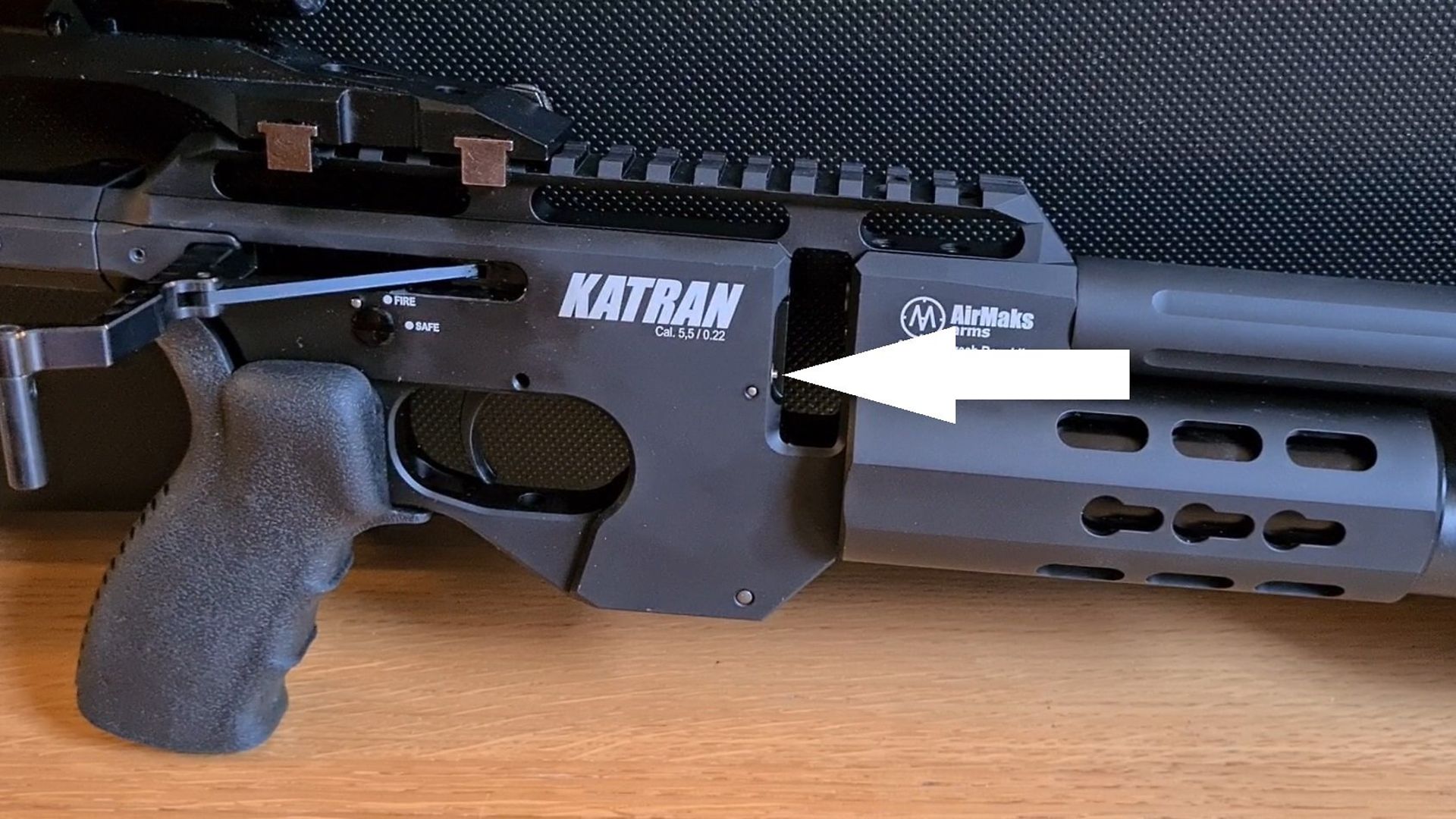 credit: Russ Douglas
credit: Russ Douglas
TECHNICAL OVERVIEW
In .22, the magazine capacity is 16 (18 in .177) and although it functioned flawlessly throughout testing, it’s not quite perfect, by my reckoning. The outer housing is made from nicely machined and anodised aluminium alloy, the rotating sprung core being synthetic. The individual pellet ‘chambers’ bear corresponding tiny faint numbers in relief, although the start/end numbers didn’t match-up with either ‘16’ or ‘1’. My preference is always for one blank chamber, so I know it’s time to reload once the cocking lever won’t return to battery; nobody likes firing blanks, and that’s easily remedied with some judicious DIY tinkering, should you purchase a Katran yourself.
The magazine slides in from the right, guided by the machined key-way on the back, and positively seats via a sprung detente. One great feature is the anti-double-load; this takes the form of a discreet pin, which projects forward into the magazine once the rifle’s cocked, stopping the mag’s core from rotating. This withdraws as the rifle is fired, or de-cocked – in which case, you must remember that you still have a pellet chambered.
Once unfolded, the skeletal stock includes a simple but comfortable, rounded plastic cheek piece, which can be raised by up to 20mm and locks via two Allen grub screws. Two more Allen screws allow the length of pull (LOP) to be increased by up to 40mm. I did this, and at full extension it perfectly fitted my long, gangly arms. One last Allen screw allows the skinny, rubber-coated, rear butt pad to slide up or down. If this were mine, though, I’d seek-out a replacement inverted butt-hook because during testing, I missed the JB3D item I have fitted to both my rifles. There was a tiny amount of wobble in the stock hinge when locked, although that wouldn’t put me off, and I’ve heard that Konstantin from Airmaks has already improved the design going forward – great to hear!
Initially, there was a small amount of play in the butt pad assembly, but I quickly fixed that by tightening the two Allen screws, anchoring it onto the twin projecting chromed bars. As soon as I saw the Katran B’s attractive folding design, a plan formed. Yes, I prefer bullpups from a purely practical everyday viewpoint because I simply can’t sling a full-length rifle over my shoulder when both arms are busy with crutches. What I wanted to try with a folding full-length rifle, was simply hooking the folded stock over a soft webbing belt slung round my neck. As you can see from the photos, this does the business, helped by me being a tall chap in the first place. I had to draw the line at walking any distance with the rifle thus slung, whilst the Huggett Mini-Magna modderator was in place because this added an extra 4.5 inches, lowering the muzzle to where it slightly caught my kneecap with each step. This would warn all the local rabbits of my presence, so wasn’t really viable. I’d keep it shouldered in my standard Swissarms rucksack gun slip, until within an area where I could start to stalk my target, then I’d attach the Mini Magna and be in business.
Whilst visiting one of my permissions, I tested the practicality of this slinging method. With the rifle hanging from my neck via the soft belt, I slowly approached a spot from where I’d shot a rabbit a few days earlier. Once in position, I quietly rested my crutches against the adjacent tree house, then carefully lifted the rifle with my right hand, whilst guiding the stock with my left, to avoid any snagging as it withdrew from the looped belt. Lastly, it was just a case of quietly unfolding the stock then shouldering and aiming. When holding the rifle by the stock and guiding the downward-pointing action with my other hand, there was no ‘click’ as the sprung hinge locked open. All this proved pleasantly easy to do, despite my mobility issues, so whilst less portable than a bullpup, if I can do this, most folk should be able to.
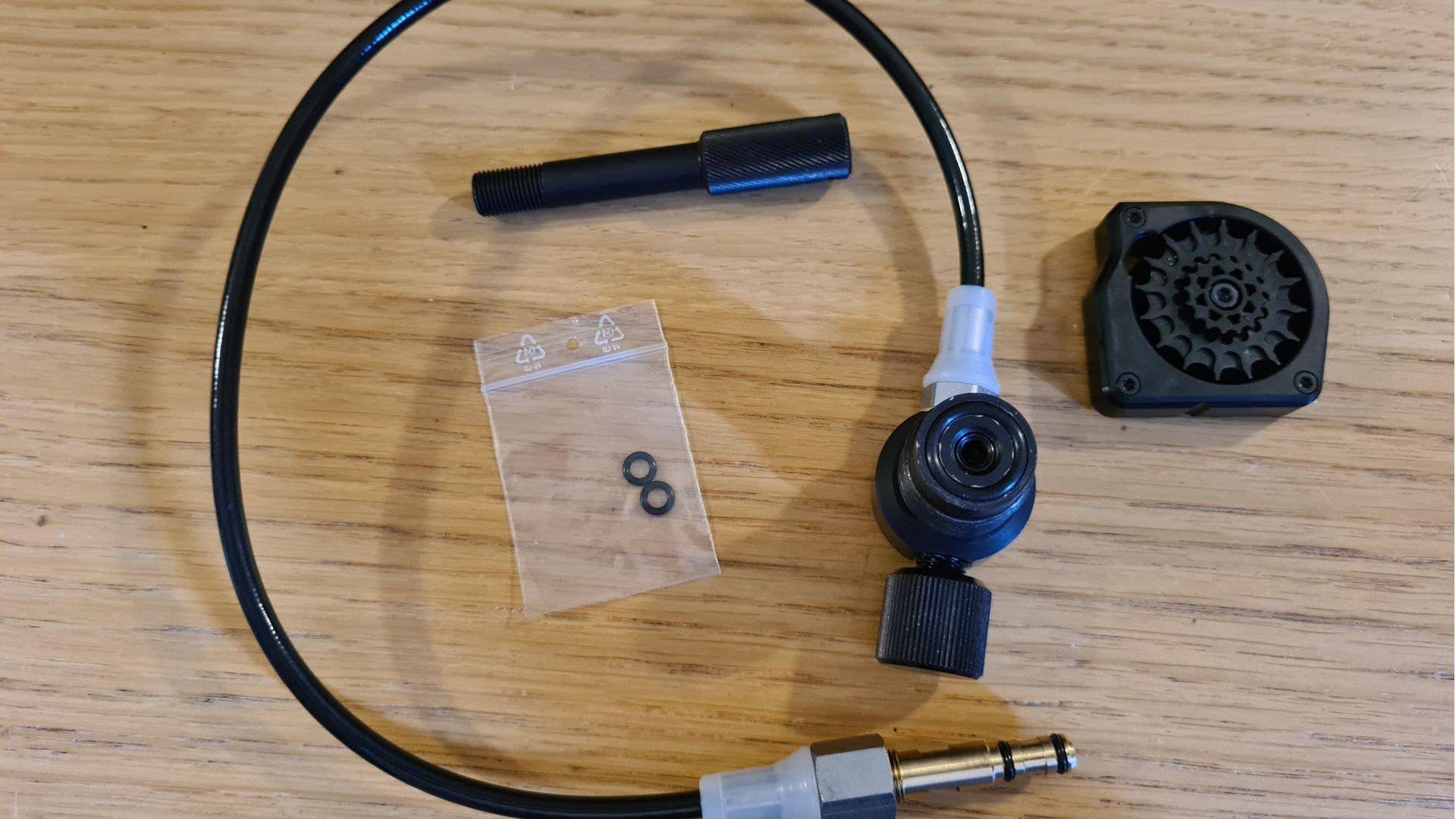 credit: Russ Douglas
credit: Russ Douglas
CAPACITY
The carbon-fibre bottle is fixed and is filled by inserting the supplied brass probe into an exposed fill port on the underside, within the keymod-equipped fore end sleeve. Definitely missing a protective synthetic plug here to keep detritus away, but filling was a doddle via the supplied brass fill probe (spare ‘O’ rings supplied), which comes as one unit connected to a standard bottle adaptor via a length of microbore hose. I soon realised that testing the maximum shot count would be beyond laborious, so here’s a little maths to guesstimate that – apologies in advance.
Max fill pressure for the 480cc carbon-fibre bottle is 300 bar, although due to the practicalities of bottle decanting, nobody’s ever going to fill it to that maximum pressure without a home compressor and some patience. Sean at BAR (thanks again, that man) reported the Katran’s reg’ was believed set at around 90 bar; 300 bar x 0.48lt = 144 litres, minus 90 bar x 0.48lt (43.2 litres) gives you a maximum usable volume of 100.8 litres of air.
Why am I telling you this? My air tank could only fill the buddy bottle to 265 bar and following my chrono’ test session, there was 200 bar left, so that session of 12 x 16-shot magazines (or 192 shots) only used 31.22 litres of air. Yes! Some of you have already sussed where I’m going … the above figures led me to calculate that this .22 rifle could potentially fire 620 shots from a full bottle down to reg’ pressure. That’s one lengthy session by anyone’s reckoning, and even the slightly less efficient smaller .177 calibre would still fuel one heck of a decent shooting session.
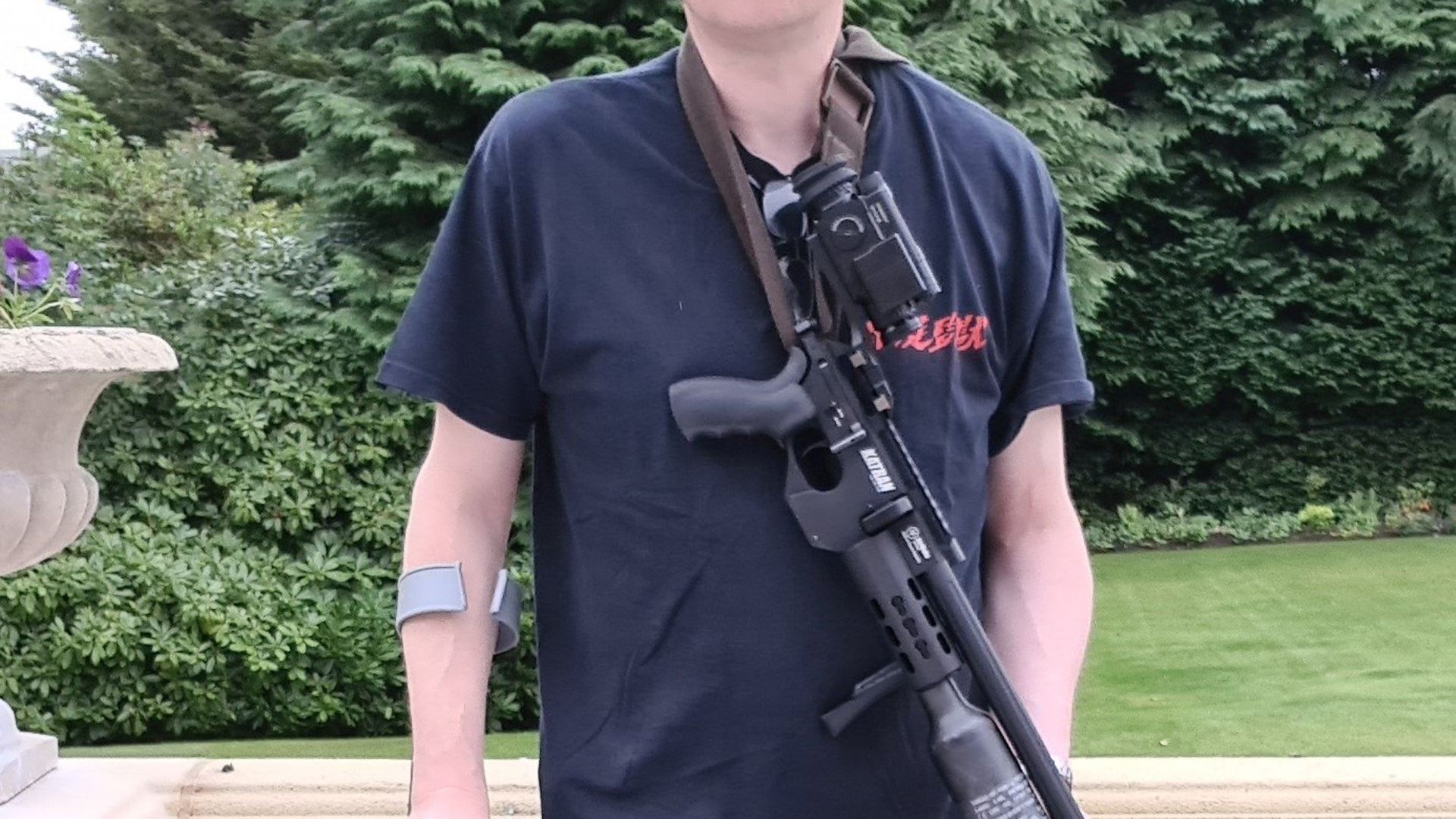 credit: Russ Douglas
credit: Russ Douglas
PERFORMANCE
The Katran didn’t quite output those test shots with a single-figure consistency FPS spread, more like varying between low single figures and upper teens, but as my range results attested, the steel vermin downrange couldn’t tell the difference. They just kept spinning or falling/resetting with a very pleasing regularity; scan the attached QR code for my video review including downrange footage recorded by my trusty Pard008LRF. I didn’t have any Keymod accessory rails in my bits box, so used a beanbag at GARC for my range tests, although as you’ll see, I’ve since attached the Saber Picatinny rail bottle clamp (60mm diameter) from my Bottle-Pup for some of the photos because the ‘Pup’s now for sale via Ythan Field Sports Supplies.
This beauty repeatedly fired .22 JSB Exacts with unerring accuracy. Half-inch spinners danced obediently at 25m, then resettable targets were repeatedly hit and reset at 30m and 35m, with just a touch of holdover as appropriate. Nick, being a fan of the larger calibre, also reported it was hitting silhouettes nicely at 50m, so it basically does exactly what you want of it.
The cool, fluted, barrel-shroud muzzle includes a neat two-piece modular moderator, with a knurled ½” UNF thread protector at the business end. These two hollow chambers unscrew to reveal the barrel itself within the fluted outer shroud. However, the reality is that as it’s a PCP and lacking a larger chamber like an FX Wildcat or Gamo Boxer, there’s still quite a bark upon firing. Removing the thread protector and adding a compact Huggett Magna moderator cured this, leaving just a muted thump with each shot.
After GARC, I popped into MY domestic permission, just as dusk approached and the decorative garden lights came on. Not a bunny was to be seen anywhere, so I didn’t get to christen the Katran and get more free-range meat for friends’ kitchens. Then again, an absence of rabbits means I’ve done my job here – for now at least – and removed the pests completely, exactly as the homeowner requested. As I prepare this article, I’ve just recovered my trusty Lidl trail-cams from positions 3 and 4 – 1 and 2 recorded only a fox and badger. They recorded the same, and despite the owner’s dog’s regular interest in the woodpile, no rabbits were seen there, only a passing skinny fox, and the fourth camera position again recorded only
the fox.
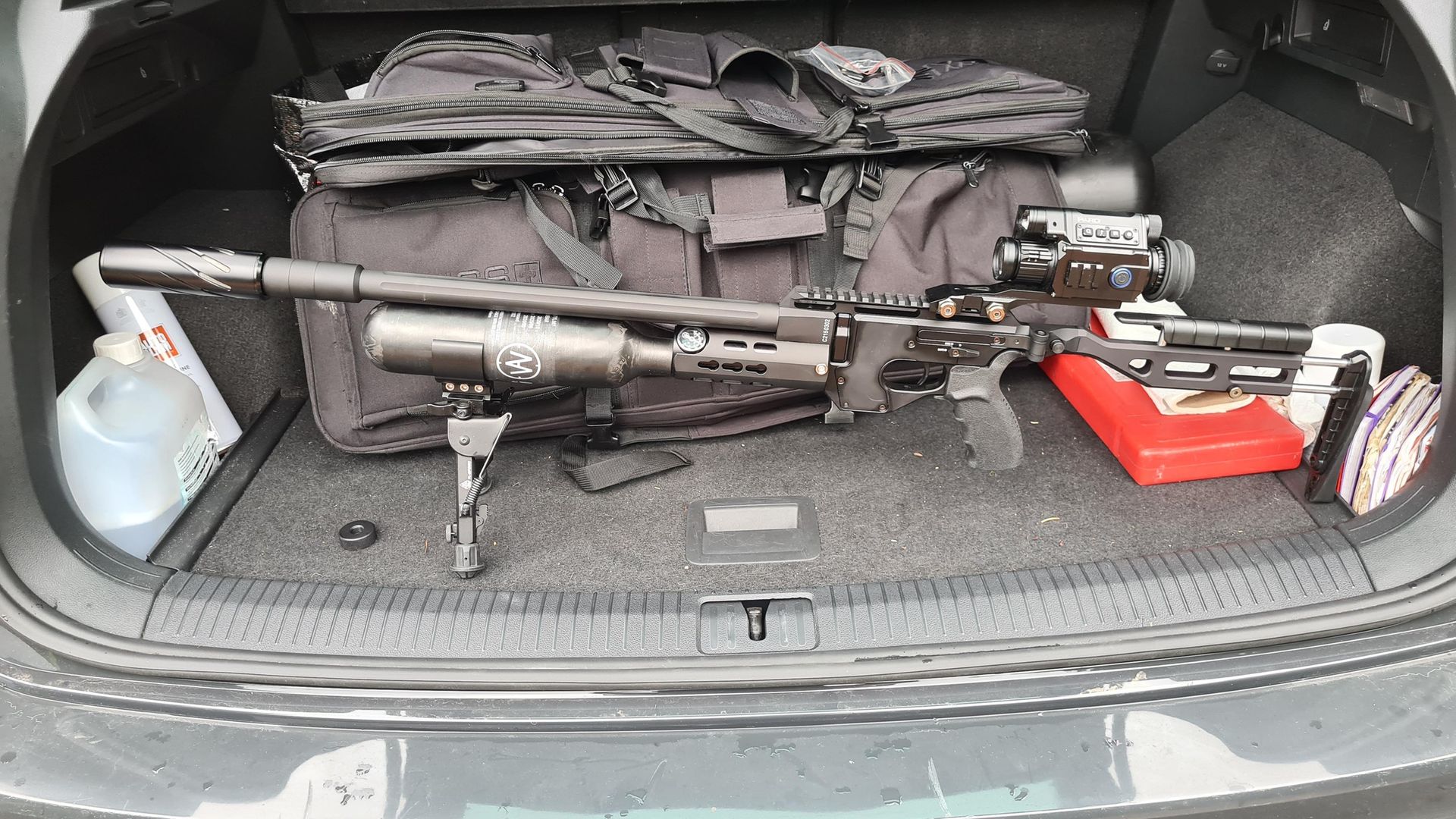 credit: Russ Douglas
credit: Russ Douglas
CONCLUSIONS
Nick, Fraser and Colin all enjoyed shooting the Katran, with Nick particularly liking the right-hand grip’s bulge, which set up his trigger finger perfectly. It hit whatever target they chose, which is what it’s all about, after all.
Thanks very much to Lloyd and Sean at Blackpool Air Rifles for the kind loan of this very cool rifle. Thanks also to Davie for taking some great photos at one of my permissions; despite my knobbly knees seeing the light of day. Lastly, thanks to the lads at GARC for their ever-honest opinions on this rifle. I hope this has been interesting, and that you enjoy your shooting.
Kit used:
Airmaks Katran B | £1,200 | Blackpool Air Rifles
EagleVisionCam 108MOA adapter for Pard008/008LRF | £99-£149.99 + VAT | Eagle Vision Cam
Pard008LRF | £899 | Sportsman Gun Centre
Saber 60mm CF bottle Picatinny clamp | £60 | Braces of Bristol